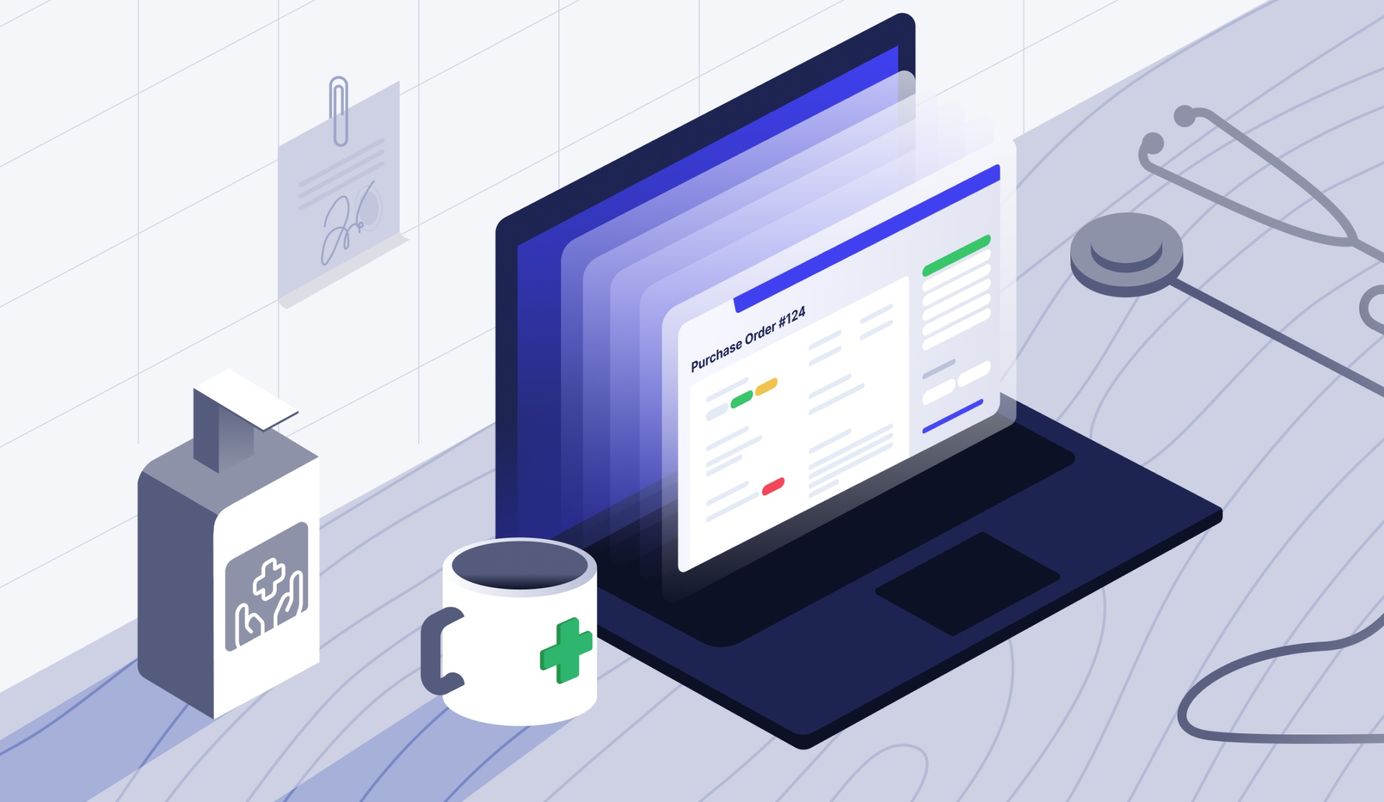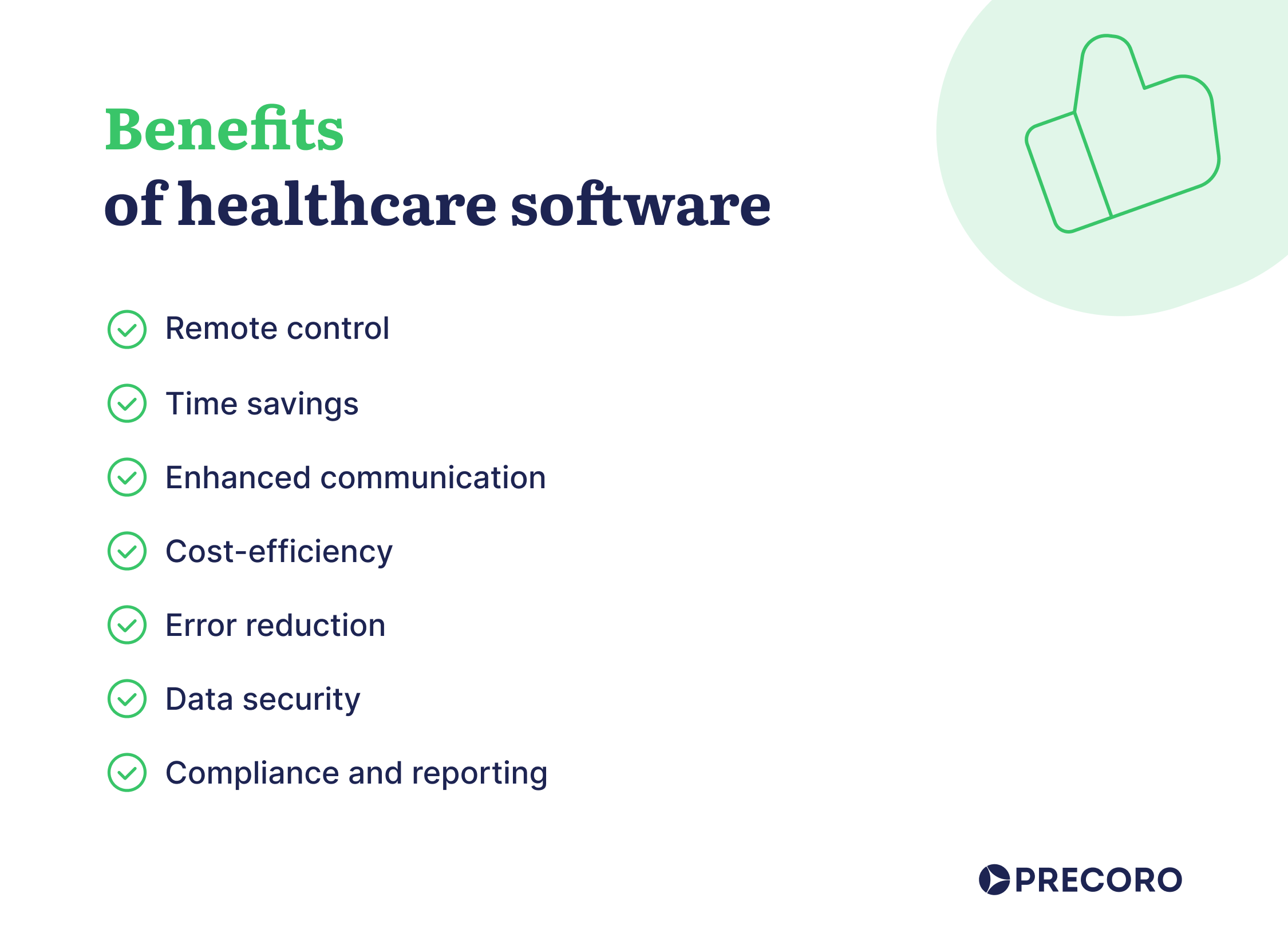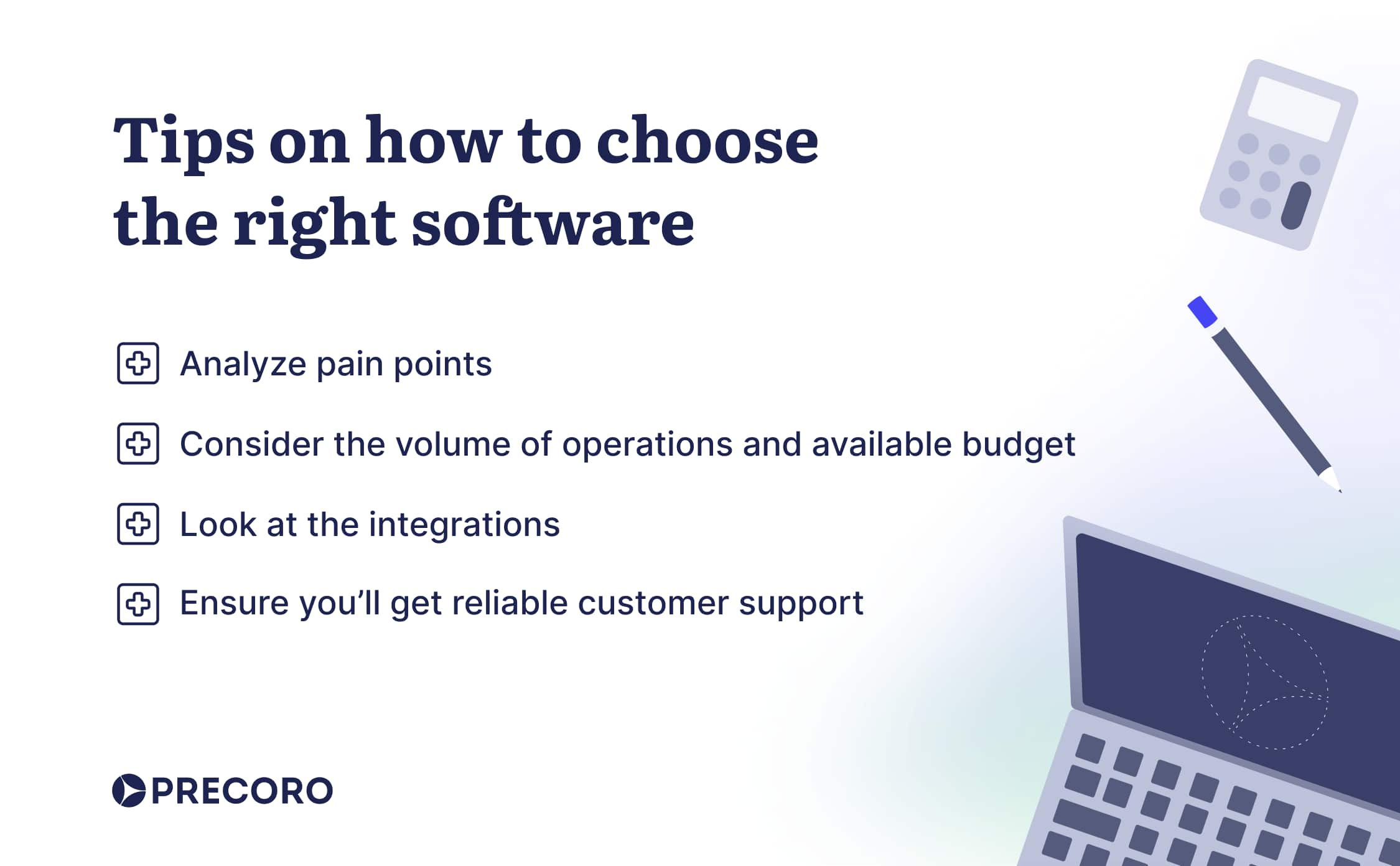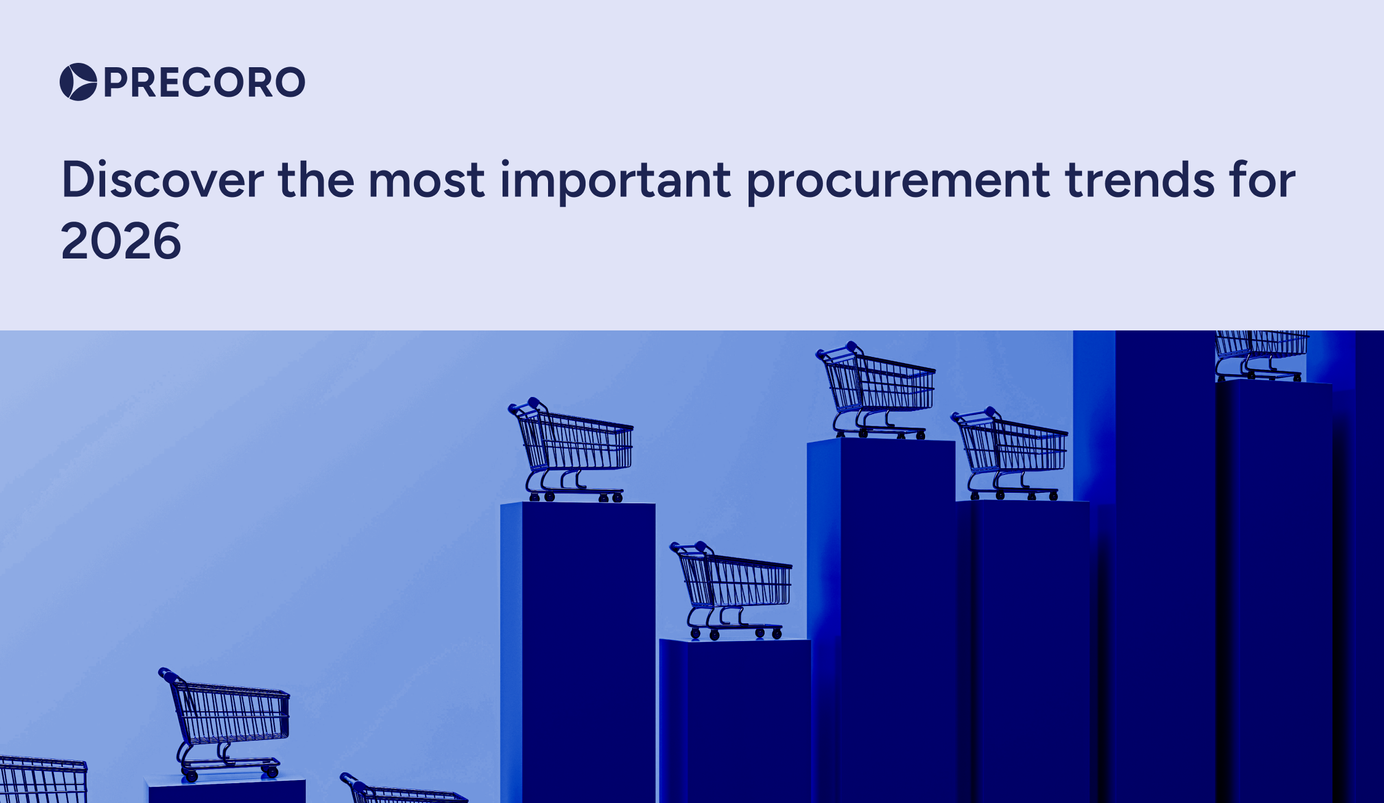
9 min read
5 Must-Have Software Solutions for the Healthcare Industry
Healthcare software can tackle various needs in the medical field. Learn about the most useful features, what kind of tools to prioritize, and how to build the best stack for your organization.
Nowadays, all industries use automation to simplify and bring maximum efficiency to their operations, and the healthcare sector is no exception. In fact, according to Precedence Research, the global market for healthcare software was estimated at USD 28.66 billion in 2022, and it is expected to reach around USD 77.43 billion by 2032.
However, navigating the large healthcare software market poses some questions: Which medical solutions should be prioritized, and what benefits does digitalization bring? In this article, we try to find answers and offer tips to help you find the optimal choice for your medical institution.
Keep reading to find out about:
- The importance of digitalization in healthcare
- Top 5 types of healthcare software solutions
- Tips on how to choose the right software
- Frequently Asked Questions
The importance of digitalization in healthcare
Healthcare software refers to automated systems that help hospitals, clinics, and other medical institutions operate smoothly and efficiently. Ultimately, medical software aims to reduce staff workload while eliminating inconsistencies and errors that can crop up in administrative, financial, and medical practices.
In practice, healthcare organizations can benefit from automating various processes, from scheduling appointments to managing suppliers. The prime candidates for automation are the following:
- Tasks performed frequently or on a regular basis.
- Time-consuming and labor-intensive processes.
- Tasks that involve data entry, data processing, or data analysis.
Healthcare software comes in various forms, each designed to simplify specific processes, and they all bring their unique benefits. However, there are some common advantages that most healthcare software solutions offer:
-
Remote control: With specialized tools, patients and healthcare providers can access medical records, medical histories, appointment schedules, and lab results anytime without back-and-forth communication or delays. Moreover, with procurement software, it’s also possible to track supplies and approve new purchases anytime, anywhere.
-
Time savings: Healthcare software automates time-consuming tasks, freeing up the medical staff to focus on efficient patient care. For example, remote patient monitoring saves time on examinations for both healthcare providers and patients. Another example is the automated extraction of patient information from identification cards or insurance documents, which speeds up the registration process.
-
Enhanced communication: Specialized software often includes secure messaging features that allow healthcare providers to communicate with each other and patients while maintaining patient data confidentiality. Additionally, procurement software for the healthcare industry streamlines communication between requesters and approvers within the medical institution, as well as communication with suppliers.
-
Cost-efficiency: Digitalization in various healthcare areas reduces operational costs by decreasing expenses related to paper and storage. Additionally, with procurement software, medical institutions can enjoy improved inventory management and spend analysis, which helps identify cost-saving opportunities.
-
Error reduction: Automation minimizes the risk of human errors, especially in billing and prescription management, enhancing patient safety and financial management.
-
Data security: Electronic health records systems implement security measures to protect patient health information and maintain patient privacy. Additionally, billing and procurement software protects the financial data of the healthcare facility.
-
Compliance and reporting: Software simplifies adherence to predefined healthcare regulations and can generate automatic reports for audits and analysis. Ultimately, incorporating it reduces the risk of compliance violations.

So, let’s take a closer look at types of medical software.
Top 5 types of healthcare software solutions
There’s a variety of medical software solutions available on the market. They can tackle various fields, including medical research, telemedicine, billing, and medical equipment management. However, when prioritizing must-have healthcare solutions, we would like to emphasize these specific types.
1. Hospital management
Hospital Management Software (HMS) is a tool that organizes the daily operations of the clinical care team and assists administrators with their regular tasks. It is on our list of essential medical software solutions due to its wide-ranging capabilities, which include:
- Organizing and tracking healthcare provider certifications and licenses to ensure that all credentials and insurance information are current.
- Keeping track of the medical professionals’ working hours and their scheduled appointments.
- Visibility into bed availability and patient placement.
- Securely collecting patient information and feedback.
- Management of personal protective equipment, vaccines for hospital workers, medications, and other inventory.
An example of a popular HMS in the medical industry is Smartsheet. In addition to the above-mentioned features, this system helps clinics, pharma companies, and medical device manufacturers with managing multiple facilities and conducting clinical trials.
2. Electronic health records
Electronic Health Record (EHR) software, also known as Electronic Medical Record (EMR), keeps a database of patients’ medical histories, lab results, updated prescriptions, and more. All necessary data is securely stored and can be easily accessed, updated, and retrieved by healthcare providers. Partnering with an EHR integration company can ensure seamless connectivity between the EHR system and other healthcare applications, improving interoperability and workflow efficiency.
Additionally, EHR systems let professionals seamlessly share patient data across different healthcare companies. As a result, medical professionals do not have to collect the same information from the same patient again and can also avoid the risk of losing or lacking essential patient health data. Similar to hospital management software, EHR systems don’t simplify just one process but rather address a multitude of tasks that include:
- Providing vital information to doctors during an emergency.
- Keeping physicians up-to-date with patients’ states.
- Alerting healthcare providers of potential prescribed medication conflicts or allergies.
- Managing appointment requests and a waitlist.
- Submitting medical bills to patients and processing payments.
- Submitting, tracking, and reconciling claims to insurance companies.
SimplePractice is one example of a well-known and popular software solution for healthcare. In addition to other benefits, this electronic health record software provides a multifunctional client portal and an integrated telehealth platform.
3. Remote patient monitoring
Remote Patient Monitoring (RPM) is an important healthcare software solution that provides the ability to collect patient medical data outside of healthcare institutions. It became an indispensable technology during the COVID-19 pandemic when clinical data management had to go digital.
RPM technology includes a variety of tools that improve in-home medical services. They include health-tracking apps, heart rate and blood pressure monitors, wearable ECG monitors, and meters for measuring glucose and blood oxygen levels. This tech comes with benefits such as:
- Allowing patients to easily and regularly update information about their conditions.
- Letting healthcare professionals remotely monitor their patients’ recovery and chronic illnesses and make accurate diagnoses.
- Alerting clinics of any detected abnormalities.
- Saving the doctor and patient time in performing routine examinations.
BioIntelliSense is an example of remote patient monitoring software that offers wearable sensors, cloud-based analytics, and notifications for potential early detection of clinical deterioration.
4. E-prescribing
E-prescribing systems make sending prescriptions from doctors to pharmacies computer-based and smooth, simplifying the dispensing of medications. E-prescribing software offers the following essential features:
- The ability for healthcare providers to electronically create and send prescriptions to pharmacies, including details such as medication name, dosage, frequency, and instructions.
- Access to patients’ complete medication histories and real-time alerts about drug interactions or allergies.
- Reporting and analytics capabilities, which can help healthcare organizations track and analyze prescription patterns, patient outcomes, and medication utilization.
MDToolbox-Rx is a US-based e-prescribing software that allows healthcare providers to sync patient data with other systems, easily find drug information, and create and send a prescription electronically, all in a quick and efficient way.
5. Procurement
Procurement programs might not be the first thing that comes to mind when you think about software solutions for the medical industry. However, healthcare organizations have a constant demand for new medical equipment, medications, diagnostic reagents, imaging supplies, patient care products, and some less obvious purchases like new furniture or janitorial supplies.
Without the help of a centralized system to keep all of those purchases under control, healthcare institutions risk overspending, time-consuming requests for new purchases, and delays in their approvals.
In fact, according to the 2022 PWC Global Digital Procurement Survey, the healthcare and pharmaceuticals industry has a lower degree of procurement digitalization but intends to catch up by 2025, as digitalization has proven to be a major support in times of crisis. Procurement software empowers healthcare institutions to efficiently manage their purchases, expenses, and budgets. Its core features comprise:
- Easy-to-use templates for requests for proposals, purchase requisitions, purchase orders, invoices, and receipts that simplify the process of making and finalizing new orders.
- Multi-level approval workflows that ensure that all purchases are authorized and approved promptly.
- The ability to set up budgets for different departments and periods of time and carefully track them.
- Centralized storage of supplier data and contracts within the system.
Precoro is procurement software suitable for various regions, including the USA, the UK, Australia, and South Africa. In addition to the above-mentioned capabilities, it can be used to create a wide range of custom reports, track inventory levels, transfer supplies, and onboard new suppliers.

Tips on how to choose the right software
While all the mentioned software is valuable for healthcare organizations, it’s crucial to determine what suits your hospital, clinic, or nursing home best and start with that. Choosing the wrong solution is a costly and time-consuming mistake. However, it can be avoided if decision-makers take into consideration the following advice.
Analyze pain points
To pinpoint what processes or tasks your healthcare institution needs to optimize, think about the daily challenges that the medical personnel face. Identify menial and time-consuming tasks that are prone to errors or cause inconveniences.
For instance, if a hospital notices that an increasing number of pharmacies no longer accept paper prescriptions, e-prescribing software becomes an essential solution. Or, let’s imagine that a clinic faces regular overspending or the staff makes purchases without receiving formal approval from the management. In that scenario, procurement software is the answer.
Consider the volume of operations and available budget
Choose your software according to the size of the healthcare institution and the available budget. It’s also a good idea to opt for simplicity over feature-heavy solutions if possible. By considering these factors, you can avoid unnecessary costs.
For instance, in hospitals or treatment centers with a high patient influx, the implementation of comprehensive EHR software and HMS tools proves beneficial. These advanced systems seamlessly integrate different departments, efficiently handle extensive patient data, and streamline processes like medical billing and appointment management. On the other hand, smaller clinics with limited resources may discover that they need to simply ensure accurate billing and insurance claims without any extra features. So they can implement medical billing software instead.
Look at the integrations
If you already use some digital tools and are looking for a new addition to your software stack, it’s a good idea to verify whether the desired platform integrates directly with your current tools or offers an open API for custom integration. This way, you’ll get smooth data exchange between programs and avoid unnecessary manual labor.
For instance, if you’re planning to have both EHR and HMS solutions, choosing integrated systems can streamline operations. Or, if you have accounting software and want to implement a procurement system, make sure they are integrated so that invoices and payment data can migrate between the tools.
Ensure you’ll get reliable customer support
Access to responsive and reliable customer support is crucial to quickly resolve issues during the implementation and training processes and ensure the smooth ongoing operation of the software. Ideally, software should provide multiple support channels, such as:
- Online chat support.
- Email support.
- Knowledge base with all features explained.
For example, Precoro, a procurement software, offers all the above-mentioned support options as well as video tutorials if required. Additionally, each company is assigned a dedicated Customer Success Manager that assists with implementation and provides continuous support.

Frequently Asked Questions
The purpose of healthcare software is to improve efficiency in healthcare delivery through the automation of administrative tasks, medical practices, and/or financial operations.
Firstly, healthcare software solutions simplify the work of staff by automating patient scheduling, billing, documentation, and more. They also provide visibility into patient data, inventory, and spending. Additionally, healthcare solutions ensure better coordination and communication among different departments. Furthermore, these tools often incorporate analytics and reporting functionalities, enabling data-driven decision-making.
Begin by evaluating the unique needs and requirements of the healthcare organization. This involves considering factors like the size of the institution, the scope of required services, and budget constraints. Assess the compatibility of the software with existing systems to ensure seamless integration. Lastly, make sure that ample customer support is offered.
Explore the healthcare software market
Healthcare software refers to systems designed to digitize administrative tasks, medical services, and financial operations for medical facilities and improve overall patient care. Medical software typically targets daily operations, time-consuming tasks, and processes that involve a large volume of transactions or data.
The fundamental benefits of healthcare software include saving time for medical staff, reducing human errors, ensuring compliance across the institution, and enhancing communication between different departments, patients, and suppliers. Other important advantages include remote control of documents, cost reduction, and data security.
There are different types of healthcare software offering a wide variety of features:
- Hospital management software provides visibility into the schedules of medical staff, bed placement, and medical inventory.
- Electronic health record software enables healthcare organizations to manage medical data, patient appointments, and bills.
- E-prescribing systems allow doctors to electronically create and send prescriptions directly to pharmacies and receive alerts about drug interactions or allergies.
- Remote patient monitoring platforms allow clinics and hospitals to monitor patient health without the need for patients to come to a physical location.
- Procurement software simplifies the process of ordering new equipment and medicines and provides visibility into budgets and expenses.
To choose the right solution for your medical institution, it’s crucial for you to assess its specific needs, analyze possible challenges, and consider its size, existing software, and budget constraints. If the software you’re interested in has a trial option, it’s a great idea to take advantage of it, as it will help you to better understand the suitability of the software to your institution’s unique requirements.









